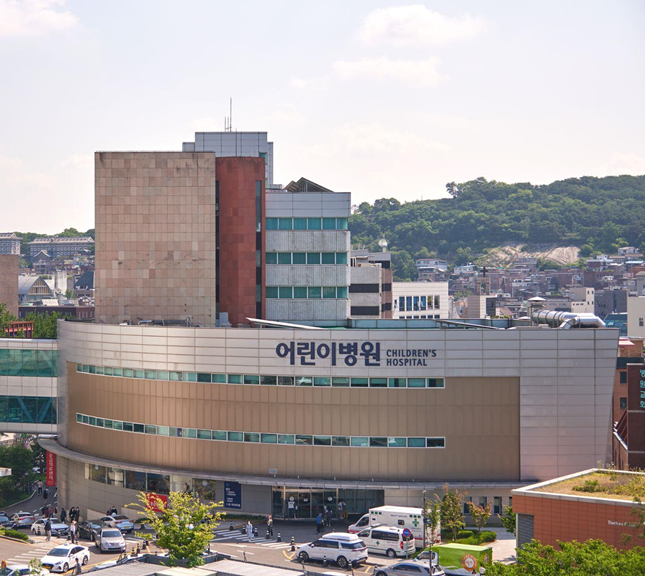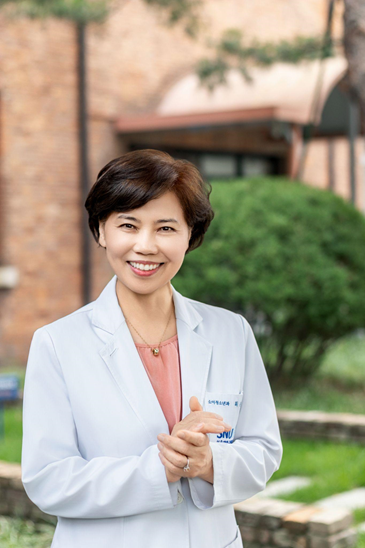40 Years of Hope and Healing Interview with the Director of SNU Children’s Hospital
 \
\
Seoul National University Children’s Hospital, founded in 1985 as Korea’s first tertiary pediatric hospital, has been a place of hope and healing for children and their families for the past 40 years. Today, with 330 beds (including 24 in the Pediatric Intensive Care Unit and 40 in the Neonatal Intensive Care Unit), 20 clinical departments, and 10 operating rooms, the hospital performs around 10,000 pediatric surgeries each year and provides world-class care for children with complex and rare conditions. Beyond Korea, many international patients also come to Seoul National University Children’s Hospital seeking advanced treatment and compassionate care.
As the hospital celebrates its 40th anniversary, it reflects on four decades of achievement while looking ahead to the next decade of innovation and service. To mark this milestone, we spoke with Professor Eun Hwa Choi, Director of Seoul National University Children’s Hospital, about the hospital’s accomplishments, its vision for the future, and the inspiring stories of children and families at the heart of its mission.
Q. Could you briefly introduce yourself and share the core values you consider most important as the Director of the Children’s Hospital?

I am a passionate pediatrician specializing in pediatric infectious diseases and vaccination. Since 2023, I have served as the Director of Seoul National University Children’s Hospital, which operates 330 beds (including 24 in the Pediatric ICU and 40 in the NICU), 20 clinical departments, and 10 operating rooms, performing around 10,000 pediatric surgeries each year. The value I consider most important as Director is to provide the best possible medical care for every child and family who entrusts their health to our hospital.
Q. Seoul National University Children’s Hospital was ranked 10th globally in Pediatrics and 1st in the Asia-Pacific region in Newsweek’s 2025 ranking, with outstanding recognition in Neonatology. What do you believe are the key factors behind this achievement, and in which areas do you see the hospital’s greatest strengths?
I believe there are three main factors behind this achievement:
- Passion for providing the best patient care through academic excellence
- Securing expertise through subspecialization in pediatrics
- A close link between research and clinical work
Many families come to our hospital with the hope of finding answers for their children’s complex or rare conditions. Some of these children could not be diagnosed properly in other hospitals, either in Korea or abroad, or were left without an effective treatment plan. Since its founding in 1985, our hospital has consistently treated such critically ill and medically complex patients, as well as those requiring highly specialized pediatric surgeries. Over four decades, this commitment has allowed our medical expertise and research outcomes to accumulate, ensuring that academic excellence and patient care go hand in hand to provide the most advanced treatments available.
Q. Looking back over the past 40 years, what achievements or milestones do you believe were possible only because of Seoul National University Children’s Hospital?
Seoul National University Children’s Hospital has grown into an institution that is now recognized as the leading pediatric medical center in the Asia-Pacific region. In 2025, we were ranked 1st in Asia-Pacific by Newsweek, reflecting the trust and excellence we have built over four decades. In 2021, we launched the Child Cancer and Rare Disease Project, established with the contribution of the late Kun-Hee Lee, taking a leading role in advancing research in pediatric oncology and rare diseases. In 2018, we established Korea’s first Integrated Care Center, where children and their families can receive comprehensive, multidisciplinary support. Earlier, in 2011, we opened the Rare Disease Center, creating a dedicated platform for the diagnosis and treatment of uncommon pediatric conditions.
Beyond these milestones within Korea, we have also shared our expertise internationally by providing training for medical professionals from countries such as Mongolia, Laos, and Uzbekistan. These achievements show how Seoul National University Children’s Hospital has shaped the landscape of pediatric medicine both domestically and globally.
Q. The Children’s Hospital is known for caring not only for patients but also for their families. Could you share a memorable story that highlights such moments of warmth with patients or their caregivers?
One unforgettable story is of a 20-month-old child with Primary Immunodeficiency who needed a bone marrow transplant. Because of the weakened immune system, the child suffered recurrent infections and had to endure prolonged stays in the intensive care unit, even requiring a ventilator and ECMO. It was an extremely difficult time for both the child and the parents, who showed remarkable strength and resilience. Thankfully, the transplant was ultimately successful, and today the child is healthy and energetic.
The child’s hospitalization lasted more than 200 days. During that time, our staff shared New Year’s greetings, celebrated the child’s birthday, and supported the family in every way possible. I will never forget the mother’s words after her child’s recovery: “Now that my child’s immune system has grown stronger, I can finally take them to crowded places.” It was a powerful reminder that our work touches not only the patients’ lives but also transforms the daily lives of their families.
Q. What recent research initiatives or new approaches is the hospital pursuing to address the major challenges in pediatric medicine?
Our hospital has been at the forefront of tackling some of the most difficult challenges in pediatric healthcare.
● Undiagnosed rare diseases: We are building a genome bank and running the Korean Undiagnosed Disease Program (UDP), enabling rapid genomic diagnosis and early treatment for ultra-rare conditions.
● Refractory pediatric malignancies: We are developing CAR-T cell therapies as innovative treatments for children who do not respond to conventional therapies.
● Moyamoya disease: Our team has pioneered SMART neurosurgery, a novel approach that has dramatically improved long-term outcomes, achieving world-class survival rates.
● Skeletal disorders: By identifying the genetic causes of rare bone diseases, we have been able to introduce new diagnostic tools and surgical innovations that are now used globally.
These efforts demonstrate how closely research and clinical practice are connected at our hospital, ensuring that discoveries can be quickly translated into better care for children.
Q. The hospital also receives patients from overseas. Which countries and conditions are most commonly seen, and could you share a particularly memorable case from your experience with international patients?
In 2019, before the COVID-19 pandemic, approximately 2,700 international pediatric patients visited our outpatient and emergency departments annually, with about 150 requiring hospitalization. Many came from Russia, the United Arab Emirates, Kazakhstan, and Mongolia.
Among them, one memorable patient from Russia was a 19-year-old with synovial sarcoma and multiple lung metastases. After being told in his home country that surgery was impossible, he came to our hospital and in 2023 successfully underwent pulmonary vein angioplasty and a left upper lobectomy. He is now recovering well under follow-up care.
Another was a 7-year-old boy from Kazakhstan who had been advised to undergo enucleation after being diagnosed with retinoblastoma. At our hospital, he received intra-arterial chemotherapy and later underwent enucleation with prosthesis implantation, which preserved both his health and quality of life.
Q. Looking ahead to the next 10 years, what is your vision for Seoul National University Children’s Hospital, and what message would you like to convey to international healthcare professionals and readers?
In the next decade, I envision Seoul National University Children’s Hospital making even greater contributions to overcoming childhood diseases and advancing medical science. We will continue to nurture outstanding pediatric specialists, not only in Korea but across the globe, thereby improving the health and well-being of children worldwide. My hope is that our hospital will always be a beacon of hope for patients and families, and a center of academic excellence and clinical expertise for healthcare professionals around the world.